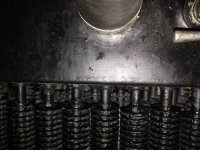Fred V
Plastic
- Joined
- Feb 14, 2012
- Location
- pensacola, fl.
I have a new radiator in a vintage Morgan 3 wheeler. The tubes are 1/4" with fins for cooling. The problem is that the tube wall is .032 and it should be maybe half that: .010" to .015" wall thickness.
If I were to take the bottom off this rad. would it be possible to use gun drills or ?? and ream the tubes out to a larger ID.
Here are some pix of the rad.


Fred V
If I were to take the bottom off this rad. would it be possible to use gun drills or ?? and ream the tubes out to a larger ID.
Here are some pix of the rad.


Fred V



